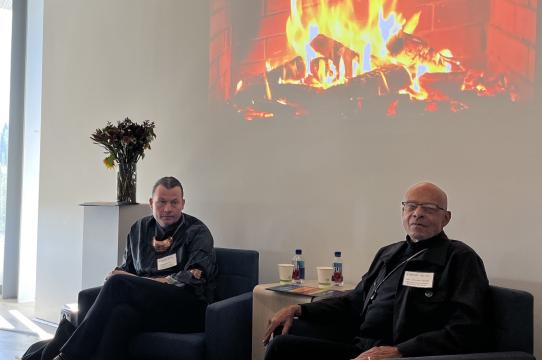Distinguished Professor Emeritus John Brown Childs enjoyed the fireside chat he and Joseph Erb, an assistant professor of Film and Digital Media, had in December 2023 at an Arts Advocacy Council meeting. There were several aspects of the conversation that appealed to Childs — including getting to discuss the Indigenous philosophies that informs his work with men in prison and Erb’s as an animator of Cherokee stories. But the best, Childs says, was getting to talk the way they did when Erb and his wife and son were neighbors on campus and would get together for dinner.
Childs is an enrolled member of the Massachusetts (Big Hill) Tribe at Ponkapoag on his mother’s side, and he says Indigenous people, like himself and Erb, make references to their family and friendships when they talk professionally.
“We used the word ‘family’ and we used the word ‘love' a lot when we spoke —our love for each other, our family's love for each other's family, love for our tribal communities,” Childs said. “Joseph also used the word ‘kindness’ a lot. What I enjoyed about that conversation was that we were able to use words like ‘love,’ ‘kindness,’ and ‘family.’”
Erb also said he welcomes any chance to have a conversation with his friend and talked about how he admires Childs’ work at the Soledad Correctional Training Facility using his philosophy of transcommunality, or peaceful conflict resolution (Childs wrote a book about it, Transcommunality: From the Politics of Conversion). Childs was also involved in the Civil Rights movement with the Friends of the Student Nonviolent Coordinating Committee, and he organized a group of students to go to the March on Washington for Jobs and Freedom.
Childs teaches men in prison to respect themselves, others, and the world around them, Erb says, and the ones he works with acquire the tools that prevent recidivism.
“Dr. John Brown Child is a courageous, caring human being who has stood for human rights, putting himself in places where it was unsafe, and going into prison systems where people would consider these people kind of like throwaway people, unworthy,” Erb said. “He’s such a brilliant man, and he spends his life honoring them, and finding ways to benefit them, and he talks about how they benefit him and his existence.”
As a child, Erb loved to draw. His drawings were often narrative, and people would tell him he should go into animation. But Erb resisted, because of some derogatory imagery of cultures, including Native ones, and because the stories that were told weren’t ones Erb could identify with. Then in graduate school, a professor got him interested in the art form, and Erb decided to tell Cherokee stories. He started with traditional ones (The Beginning They Told, a creation story with a talking beaver, buzzard and water beetle has been shown at the Smithsonian), and later moved into contemporary themes.
“I realized that this medium was actually quite powerful,” he said. “I could use the language and the imagery of today in a way that had not been done before.”
Erb was a teacher’s assistant in computer animation classes at the University of Pennsylvania, and he was asked to stay and teach. But he passed it up.
“I wanted to move back to the Cherokee Nation and teach people back home,” he said. “I spent years working to tell stories and train others to tell stories in the language. It was really an exciting time. I realized this is not a white medium. It’s a medium that could be mine in how I was about to address it and some of the elements I was able to use.”
Erb says he is happy to spend his time making underfunded animations — and teaching others — because he thinks it’s so important for people to hear the Cherokee language. The animation will become antiquated, he says, but the significance of the words will remain.
“In 200 years, my work will still be valuable, not only to my community and the Cherokee Nation, but to know at this time, this period, I made work in this language,” he said. “Hopefully we'll have a language in 200 years, but whether we do or not, this is the sound of our language today.”
photos by Gabby Goss



